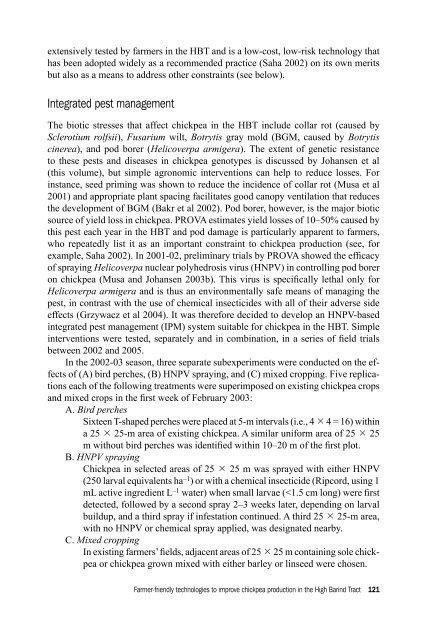Download (2461kB) - University of Greenwich
Download (2461kB) - University of Greenwich
Download (2461kB) - University of Greenwich
- No tags were found...
You also want an ePaper? Increase the reach of your titles
YUMPU automatically turns print PDFs into web optimized ePapers that Google loves.
extensively tested by farmers in the HBT and is a low-cost, low-risk technology thathas been adopted widely as a recommended practice (Saha 2002) on its own meritsbut also as a means to address other constraints (see below).Integrated pest managementThe biotic stresses that affect chickpea in the HBT include collar rot (caused bySclerotium rolfsii), Fusarium wilt, Botrytis gray mold (BGM, caused by Botrytiscinerea), and pod borer (Helicoverpa armigera). The extent <strong>of</strong> genetic resistanceto these pests and diseases in chickpea genotypes is discussed by Johansen et al(this volume), but simple agronomic interventions can help to reduce losses. Forinstance, seed priming was shown to reduce the incidence <strong>of</strong> collar rot (Musa et al2001) and appropriate plant spacing facilitates good canopy ventilation that reducesthe development <strong>of</strong> BGM (Bakr et al 2002). Pod borer, however, is the major bioticsource <strong>of</strong> yield loss in chickpea. PROVA estimates yield losses <strong>of</strong> 10–50% caused bythis pest each year in the HBT and pod damage is particularly apparent to farmers,who repeatedly list it as an important constraint to chickpea production (see, forexample, Saha 2002). In 2001-02, preliminary trials by PROVA showed the efficacy<strong>of</strong> spraying Helicoverpa nuclear polyhedrosis virus (HNPV) in controlling pod boreron chickpea (Musa and Johansen 2003b). This virus is specifically lethal only forHelicoverpa armigera and is thus an environmentally safe means <strong>of</strong> managing thepest, in contrast with the use <strong>of</strong> chemical insecticides with all <strong>of</strong> their adverse sideeffects (Grzywacz et al 2004). It was therefore decided to develop an HNPV-basedintegrated pest management (IPM) system suitable for chickpea in the HBT. Simpleinterventions were tested, separately and in combination, in a series <strong>of</strong> field trialsbetween 2002 and 2005.In the 2002-03 season, three separate subexperiments were conducted on the effects<strong>of</strong> (A) bird perches, (B) HNPV spraying, and (C) mixed cropping. Five replicationseach <strong>of</strong> the following treatments were superimposed on existing chickpea cropsand mixed crops in the first week <strong>of</strong> February 2003:A. Bird perchesSixteen T-shaped perches were placed at 5-m intervals (i.e., 4 4 = 16) withina 25 25-m area <strong>of</strong> existing chickpea. A similar uniform area <strong>of</strong> 25 25m without bird perches was identified within 10–20 m <strong>of</strong> the first plot.B. HNPV sprayingChickpea in selected areas <strong>of</strong> 25 25 m was sprayed with either HNPV(250 larval equivalents ha –1 ) or with a chemical insecticide (Ripcord, using 1mL active ingredient L –1 water) when small larvae (
















